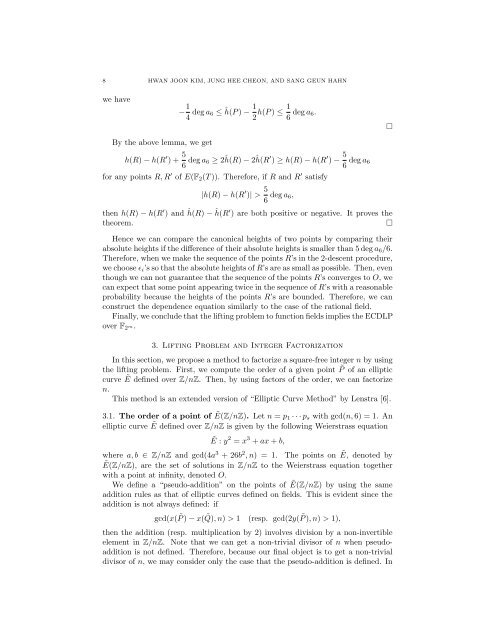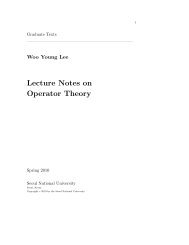ON REMARKS OF LIFTING PROBLEMS FOR ELLIPTIC CURVES 1 ...
ON REMARKS OF LIFTING PROBLEMS FOR ELLIPTIC CURVES 1 ...
ON REMARKS OF LIFTING PROBLEMS FOR ELLIPTIC CURVES 1 ...
Create successful ePaper yourself
Turn your PDF publications into a flip-book with our unique Google optimized e-Paper software.
8 HWAN JO<strong>ON</strong> KIM, JUNG HEE CHE<strong>ON</strong>, AND SANG GEUN HAHN<br />
we have<br />
− 1 4 deg a 6 ≤ ĥ(P ) − 1 2 h(P ) ≤ 1 6 deg a 6.<br />
□<br />
By the above lemma, we get<br />
h(R) − h(R ′ ) + 5 6 deg a 6 ≥ 2ĥ(R) − 2ĥ(R′ ) ≥ h(R) − h(R ′ ) − 5 6 deg a 6<br />
for any points R, R ′ of E(F 2 (T )). Therefore, if R and R ′ satisfy<br />
|h(R) − h(R ′ )| > 5 6 deg a 6,<br />
then h(R) − h(R ′ ) and ĥ(R) − ĥ(R′ ) are both positive or negative. It proves the<br />
theorem.<br />
□<br />
Hence we can compare the canonical heights of two points by comparing their<br />
absolute heights if the difference of their absolute heights is smaller than 5 deg a 6 /6.<br />
Therefore, when we make the sequence of the points R’s in the 2-descent procedure,<br />
we choose ɛ i ’s so that the absolute heights of R’s are as small as possible. Then, even<br />
though we can not guarantee that the sequence of the points R’s converges to O, we<br />
can expect that some point appearing twice in the sequence of R’s with a reasonable<br />
probability because the heights of the points R’s are bounded. Therefore, we can<br />
construct the dependence equation similarly to the case of the rational field.<br />
Finally, we conclude that the lifting problem to function fields implies the ECDLP<br />
over F 2 m.<br />
3. Lifting Problem and Integer Factorization<br />
In this section, we propose a method to factorize a square-free integer n by using<br />
the lifting problem. First, we compute the order of a given point ˜P of an elliptic<br />
curve Ẽ defined over Z/nZ. Then, by using factors of the order, we can factorize<br />
n.<br />
This method is an extended version of “Elliptic Curve Method” by Lenstra [6].<br />
3.1. The order of a point of Ẽ(Z/nZ). Let n = p 1 · · · p s with gcd(n, 6) = 1. An<br />
elliptic curve Ẽ defined over Z/nZ is given by the following Weierstrass equation<br />
Ẽ : y 2 = x 3 + ax + b,<br />
where a, b ∈ Z/nZ and gcd(4a 3 + 26b 2 , n) = 1. The points on Ẽ, denoted by<br />
Ẽ(Z/nZ), are the set of solutions in Z/nZ to the Weierstrass equation together<br />
with a point at infinity, denoted O.<br />
We define a “pseudo-addition” on the points of Ẽ(Z/nZ) by using the same<br />
addition rules as that of elliptic curves defined on fields. This is evident since the<br />
addition is not always defined: if<br />
gcd(x( ˜P ) − x( ˜Q), n) > 1 (resp. gcd(2y( ˜P ), n) > 1),<br />
then the addition (resp. multiplication by 2) involves division by a non-invertible<br />
element in Z/nZ. Note that we can get a non-trivial divisor of n when pseudoaddition<br />
is not defined. Therefore, because our final object is to get a non-trivial<br />
divisor of n, we may consider only the case that the pseudo-addition is defined. In













